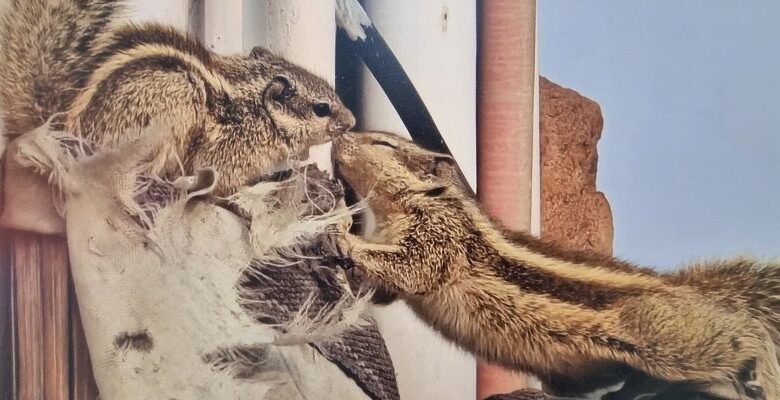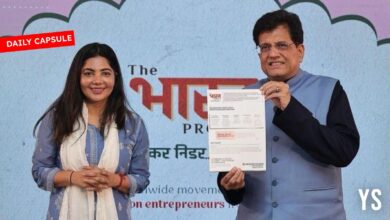Stories, synergy, sustainability: WAC 2025 festival celebrates new frontiers in art

Launched in 2014, PhotoSparks is a weekly feature from YourStory, with photographs that celebrate the spirit of creativity and innovation. In the earlier 870 posts, we featured an art festival, cartoon gallery. world music festival, telecom expo, millets fair, climate change expo, wildlife conference, startup festival, Diwali rangoli, and jazz festival.
The Whitefield Art Collective (WAC) is wrapping up the eighth edition of its annual arts festival at the VR Bengaluru mall this month. See YourStory’s coverage of earlier editions of WAC exhibitions from 2017 onwards here.

In addition to paintings and installations, the festival includes a Young Artists Programme, a competition for budding young artists. There is also a puppet show and workshop, along with digital exhibits.
The WAC festivals embrace both traditional and modern art forms. “We encourage artists to explore AI and other new tools,” WAC curator Sumi Gupta tells YourStory.
“This blend of old and new fosters creativity, challenges conventions, and helps shape the future of art This keeps art vibrant and relevant for diverse audiences,” she adds.

.thumbnailWrapper{
width:6.62rem !important;
}
.alsoReadTitleImage{
min-width: 81px !important;
min-height: 81px !important;
}
.alsoReadMainTitleText{
font-size: 14px !important;
line-height: 20px !important;
}
.alsoReadHeadText{
font-size: 24px !important;
line-height: 20px !important;
}
}

The rise of generative AI (GenAI) has opened up new opportunities as well as challenges for creative communities. “When computers first emerged, many feared job losses, but instead, they created new opportunities and transformed industries,” Gupta observes.
The same holds true for AI in the arts. “It offers new creative possibilities that complement traditional art, allowing artists to push boundaries while staying connected to time-honoured practices,” she explains.
“Just as technology has always evolved alongside art, AI enhances rather than replaces the artist’s vision. It enables more experimentation and deeper engagement,” she says.

A new feature at WAC 2025 was the sustainable fashion parade at The Whitefield Arms craft brewery, titled The Next Wave: Circular Fashion for a New Era. It was put together by fashion stylist Prasad Bidappa and Rajini Rekha, founder of Reves Art Gallery.
“The vision behind the show was to spark a movement toward mindful consumption and circular fashion. The collection reimagined professional wear through the lens of sustainability—championing garments that are timeless, versatile, and kind to the planet,” Rekha explains.
Fashion can be both functional and expressive, while being deeply rooted in eco-conscious values, she affirms. For example, the collection featured upcycled fibers, reversible styles, and modular pieces designed for layering and longevity.

.thumbnailWrapper{
width:6.62rem !important;
}
.alsoReadTitleImage{
min-width: 81px !important;
min-height: 81px !important;
}
.alsoReadMainTitleText{
font-size: 14px !important;
line-height: 20px !important;
}
.alsoReadHeadText{
font-size: 24px !important;
line-height: 20px !important;
}
}

“The fusion of art and fashion transformed garments into wearable canvases. Natural textures, untreated fabrics, and a sense of fluidity underscored the collection’s quiet power,” Rekha proudly says.
She observes that the sustainability space offers an exciting frontier for designers and artists, where creativity meets conscious innovation. “As the world shifts toward responsible consumption and circular systems, there’s a growing demand for ideas that blend purpose with aesthetics,” she adds.
Cross-disciplinary projects between fashion, art, science, and technology are thriving. “Artists and designers can co-create solutions with environmentalists, fabric technologists, or rural artisans to develop both local and scalable impact,” she explains.

However, several myths continue to cloud public perception of sustainability. Sustainable fashion is seen as only expensive or largely for the elite. “Some think that eco-friendly products are not stylish or modern, or that one person’s effort does not make a difference,” Rekha observes.
She was pleased with the audience’s overall reception to the show. “Many shared how refreshing it was to see sustainability presented not as a limitation, but as a canvas for innovation. It resonated particularly well with professionals seeking both elegance and ethics in their wardrobe,” she says.
There were requests for more workshops and collaboration opportunities with young artists and craft communities. People were looking for ways to nurture local talent and broaden the sustainability circle.

.thumbnailWrapper{
width:6.62rem !important;
}
.alsoReadTitleImage{
min-width: 81px !important;
min-height: 81px !important;
}
.alsoReadMainTitleText{
font-size: 14px !important;
line-height: 20px !important;
}
.alsoReadHeadText{
font-size: 24px !important;
line-height: 20px !important;
}
}

“The show also sparked ideas for seasonless collections,” Rekha adds, urging designers and audiences to choose with intention, wear with pride, and create with purpose.
“Fashion is not just about trends. It is about telling your story, aligning with your values, and shaping the future through the choices you make every day. When we embrace sustainability, we are not just preserving the planet—we are honoring craftsmanship, culture, and consciousness,” she affirms.
The festival reflected opportunities for collaboration at a local and global level, with WAC curator Gupta having wide experience with art festivals in India and the UK. “One of my favourite international festivals where Indian art is showcased is the Frieze Art Fair in London,” she says.

This event brings together global galleries, artists, and collectors. It offers a unique platform for contemporary Indian art to be exhibited alongside works from around the world.
“It is an exciting opportunity for Indian artists to gain international exposure and for global audiences to engage with the rich diversity of India’s artistic landscape,” she adds.
“WAC is a celebration of inclusivity and diversity. We offer something for everyone, regardless of age, background, or interests,” Gupta says.

.thumbnailWrapper{
width:6.62rem !important;
}
.alsoReadTitleImage{
min-width: 81px !important;
min-height: 81px !important;
}
.alsoReadMainTitleText{
font-size: 14px !important;
line-height: 20px !important;
}
.alsoReadHeadText{
font-size: 24px !important;
line-height: 20px !important;
}
}

While art is often restricted to galleries, WAC brings it to open spaces like the Virtuous Retail (VR) centres. This makes art accessible to the public and sparks social dialogue.
“The festival offers a truly unique experience by bringing art, culture, and community together in a mixed-use development. Unlike traditional festivals, you can explore art while shopping, dining, or enjoying a day out,” Gupta signs off.
Now what have you done today to pause in your busy schedule and harness your creative side for a better world?










(All exhibition photographs were taken by Madanmohan Rao on location at VR Bengaluru.)
Edited by Swetha Kannan






